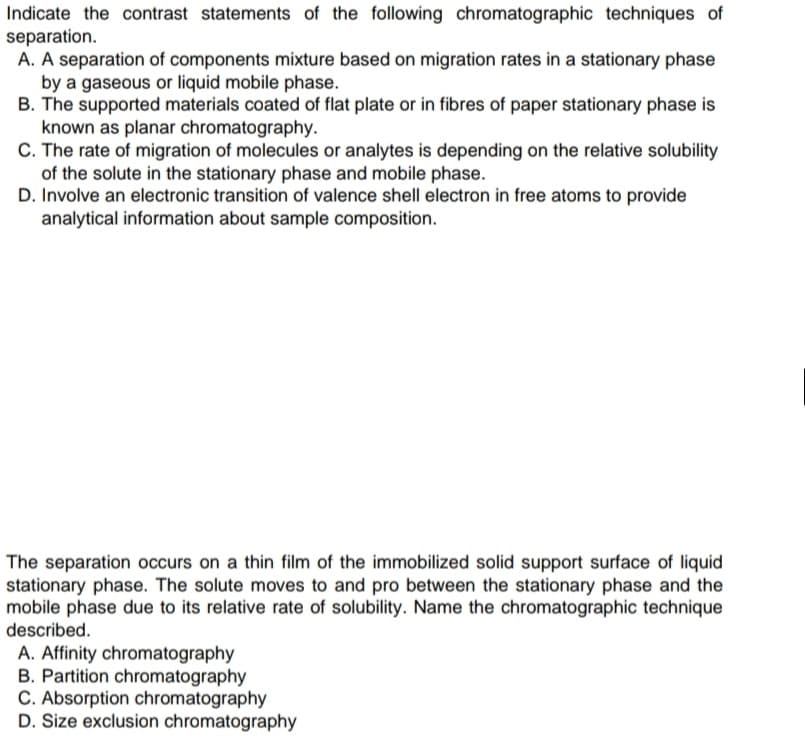Indicate the contrast statements of the following chromatographic techniques of separation. A. A separation of components mixture based on migration rates in a stationary phase by a gaseous or liquid mobile phase. B. The supported materials coated of flat plate or in fibres of paper stationary phase is known as planar chromatography. C. The rate of migration of molecules or analytes is depending on the relative solubility of the solute in the stationary phase and mobile phase. D. Involve an electronic transition of valence shell electron in free atoms to provide analytical information about sample composition.
Indicate the contrast statements of the following chromatographic techniques of separation. A. A separation of components mixture based on migration rates in a stationary phase by a gaseous or liquid mobile phase. B. The supported materials coated of flat plate or in fibres of paper stationary phase is known as planar chromatography. C. The rate of migration of molecules or analytes is depending on the relative solubility of the solute in the stationary phase and mobile phase. D. Involve an electronic transition of valence shell electron in free atoms to provide analytical information about sample composition.
Principles of Instrumental Analysis
7th Edition
ISBN:9781305577213
Author:Douglas A. Skoog, F. James Holler, Stanley R. Crouch
Publisher:Douglas A. Skoog, F. James Holler, Stanley R. Crouch
Chapter28: High-performance Liquid Chromatography
Section: Chapter Questions
Problem 28.21QAP
Related questions
Question

Transcribed Image Text:Indicate the contrast statements of the following chromatographic techniques of
separation.
A. A separation of components mixture based on migration rates in a stationary phase
by a gaseous or liquid mobile phase.
B. The supported materials coated of flat plate or in fibres of paper stationary phase is
known as planar chromatography.
C. The rate of migration of molecules or analytes is depending on the relative solubility
of the solute in the stationary phase and mobile phase.
D. Involve an electronic transition of valence shell electron in free atoms to provide
analytical information about sample composition.
The separation occurs on a thin film of the immobilized solid support surface of liquid
stationary phase. The solute moves to and pro between the stationary phase and the
mobile phase due to its relative rate of solubility. Name the chromatographic technique
described.
A. Affinity chromatography
B. Partition chromatography
C. Absorption chromatography
D. Size exclusion chromatography
Expert Solution
This question has been solved!
Explore an expertly crafted, step-by-step solution for a thorough understanding of key concepts.
Step by step
Solved in 2 steps

Knowledge Booster
Learn more about
Need a deep-dive on the concept behind this application? Look no further. Learn more about this topic, chemistry and related others by exploring similar questions and additional content below.Recommended textbooks for you

Principles of Instrumental Analysis
Chemistry
ISBN:
9781305577213
Author:
Douglas A. Skoog, F. James Holler, Stanley R. Crouch
Publisher:
Cengage Learning


Macroscale and Microscale Organic Experiments
Chemistry
ISBN:
9781305577190
Author:
Kenneth L. Williamson, Katherine M. Masters
Publisher:
Brooks Cole

Principles of Instrumental Analysis
Chemistry
ISBN:
9781305577213
Author:
Douglas A. Skoog, F. James Holler, Stanley R. Crouch
Publisher:
Cengage Learning


Macroscale and Microscale Organic Experiments
Chemistry
ISBN:
9781305577190
Author:
Kenneth L. Williamson, Katherine M. Masters
Publisher:
Brooks Cole